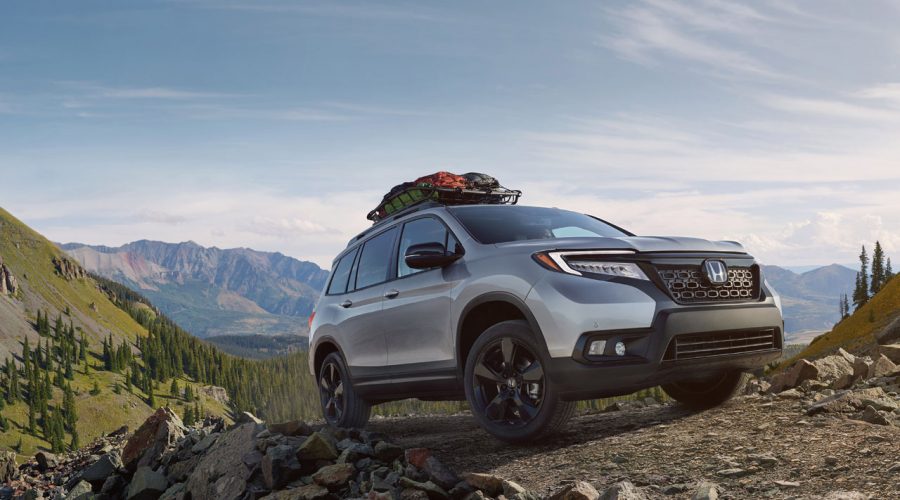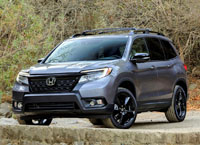
None of us should be surprised when an automaker launches a new sport utility vehicle these days, but some new entries make more sense than others. For reasons that likely have something to do with North American average sized families (which as of 2016 were estimated at 2.9 persons in Canada, and as of 2017 were 3.14 in the U.S.—which is larger than the EU’s 2.3-person average), five-passenger mid-size SUVs sell better than their larger seven-passenger siblings.
For example the best-selling five-passenger Santa Fe obliterated the larger Santa Fe XL last year with 21,615 deliveries compared to just 6,787, while the next most popular Ford Edge merely nosed out the Explorer with 19,967 unit sales to 17,333. Likewise, the five-occupant Nissan Murano was ahead of the Pathfinder with 15,120 sales to 9,838, and just in case you’re wondering whether brands that only offer seven-passenger crossovers sell much more than those that provide both, consider that the Kia Sorento only sold 15,990 units, the Toyota Highlander just 15,259, the Dodge Journey 13,745, and the Pilot just 8,905.
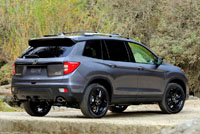
Other brands fared worse than Honda, with the Dodge Durango down at 6,505 units, GMC Acadia at 5,380, Chevrolet Traverse at 4,710, Volkswagen Atlas at 4,534 (after just seven months of sales), Mazda CX-9 at 3,943, plus a couple of stragglers not worth mentioning, but no doubt the brand that produces the CR-V, Canada’s best-selling compact SUV, and does nearly as well with the HR-V in the subcompact SUV segment, wants to find similar success in the mid-size utility class.
Set to arrive in Honda dealerships across Canada early next year, the 2019 Passport will attempt to recharge the brand’s lagging mid-size sales by targeting two types of SUV buyers, those who simply want more passenger and cargo space than a CR-V can provide, without the added length of a three-row utility, and more adventurous owners who’d like to take their new SUV off the beaten track.
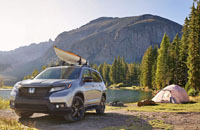
If you’ve been watching Honda’s automotive news stream lately you’ve probably seen greater focus than usual put on off-road performance, with last month’s Ridgeline-based Rugged Open Air Vehicle Concept now seeming like a precursor to a couple of similarly styled all-terrain vehicles, the Talon 1000X and Talon 1000R, introduced alongside the new Passport on Tuesday, November 27. Those not familiar with Honda’s motorcycle and ATV divisions might find all of the above a surprise, but the idea of Honda going off-road will be nothing new to fans of the brand who were weaned on CRs, XLs and XRs, ATCs, TRXs and Four-Trax’s, and most specifically FLs, otherwise known as Honda Odysseys, which were little single-seat four-wheel off-roaders around well before anyone ever heard of a minivan (Honda also made a Pilot ATV in 1989 and 1990), and are closest in concept to the two new Talon ATVs.
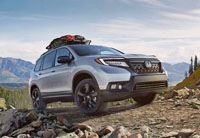
Tapping into Honda’s off-road heritage makes a great deal of sense for the brand’s SUV lineup as well as its sole Ridgeline pickup truck, as there’s a lot of missed opportunity for cross-marketing Honda SUVs with Honda dirt bikes and ATVs, not to mention Honda generators and water pumps that would fit nicely into camping lifestyle ad campaigns, and its lawnmowers, handheld edge trimmers, tillers, snowblowers, and more that fit ideally into the lives of home and cabin/cottage owners. The Ridgeline is the more appropriate cross-marketing product for the latter items, but the new off-road capable Passport makes a good fit for anything camping related.
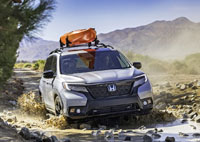
The new Passport would be ideal for trailering all of the recreation vehicles and handy tools noted above (see photos of it towing the new Talon and a camp trailer in the gallery), not to mention boats powered by Honda Marine outboard engines and Honda AquaTrax personal watercraft (although you’ll need to have a used one of the latter being that Honda recently pulled out of the industry), thanks to an optional tow package rated at 1,588 kilograms (3,500 lbs) for front-wheel drive models and 2,268 kilos (5,000 lbs) with all-wheel drive. What’s more, the “overhead” option found in the new Passport’s standard multi-view rearview camera makes connecting hitch and trailer easier than ever before.
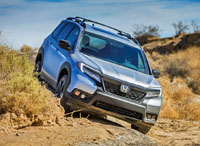
Off-road enthusiasts who might have considered a Ridgeline, but never a Pilot or CR-V, will find the new Passport a serious alternative to other medium-duty 4×4 capable SUVs thanks to Honda’s upgraded i-VTM4 all-wheel drive system, which uses active torque vectoring to send up to 70 percent of engine torque to the rear axle and 100 percent to either the left or right rear wheels. Honda promises handling excellence no matter the conditions, citing “rain-slicked or snowy roads or sandy trails,” whereas on pavement it also responds better by overdriving the outside rear wheels amid turns.

Honda’s Intelligent Traction Management (ITM) adds another element to the Passport’s off-road prowess, thanks to four driving modes that work in tandem with the optional i-VTM4 all-wheel drive, including normal, snow, mud and sand selections. ITM is actually standard with both FWD and AWD models, although the drive modes for the former only include normal and snow settings. Also notable, the new Passport adds 13 mm (0.5 in) of ground clearance over its Pilot sibling in FWD guise, and 28 mm (1.1 in) with AWD, allowing greater ability to overcome obstacles like rocks and roots found on the trail.
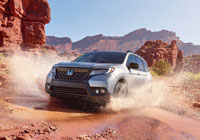
So how does the Passport AWD do in off-road conditions? As you can see by the photos provided with its launch material, it certainly looks more capable than any previous Honda SUV, at least anything designed and produced by Honda (let’s not forget about the 1993–2002 Isuzu Rodeo-based mid-size model of the same name that could be considered the spiritual successor to this new Passport, and the reason Honda may have chosen to dig up this old name from the mostly forgotten past. Back to the here and now, Honda thoroughly tested the new Passport in “the world’s harshest environments” like “the sands of Dubai, muddy country roads of Russia, and snowbound trails in Minnesota,” and claims that it’s “more capable off road than many unibody SUVs.” Basically they’re saying not to expect it to out-4×4 a Jeep Wrangler, but when up against a similarly equipped unibody crossover SUV that doesn’t offer a bull-low gear ratio, the combination of i-VTM4 and ITM allow AWD-equipped Passports hold their own.
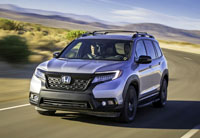
While all of this is fun and interesting, we all know the majority of Passport owners will never take their SUV off pavement and therefore might only ever experience slippery road conditions from rain, snow and ice. As noted earlier Honda has this covered too, while also providing the most powerful base engine in its class, which is both a boon and a bane. The automaker turns to the same i-VTEC valvetrain-enhanced 3.5-litre V6 found in the larger Pilot and Ridgeline pickup truck, not to mention the Odyssey minivan mentioned earlier. On the positive this sole engine makes 280 horsepower and 262 lb-ft of torque, and while it’s usually good to offer the strongest performance in a segment it’s not necessarily the best to come up short when it comes to fuel economy.
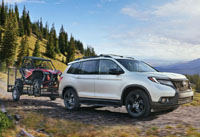
Of course, Honda makes no official fuel consumption claims yet, but we can assume the new model will do better than the base Pilot’s 13.0 L/100km city, 9.3 highway and 11.3 rating due to weighing considerably less and featuring a standard nine-speed automatic transmission with pushbutton gear selection, instead of the more traditional lever operated six-speed unit offered in lower trims of the larger SUV. Higher Pilot trims feature the same nine-speed, and its fuel economy reflects this with a thriftier rating of 12.4 city, 9.3 highway and 11.0 combined, so the new Passport should be able to improve on the latter numbers, while providing smoother and more refined performance than four-cylinder powered competitors that achieve better mileage.
As you may have guessed the new Passport rides on the same fully independent chassis as the Pilot, the Honda Global Light Truck platform consisting of a rigid unibody structure with a fully boxed floor held up by a MacPherson strut front and independent multi-link rear suspension setup, and featuring electric power-assisted rack-and-pinion steering directing standard 20-inch alloy wheels wrapped in 245/50 all-season tires in base Sport and EX-L trims or 265/45 tires in Touring and Elite trims.
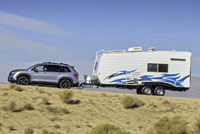
Of note, the Passport launch model, which was introduced as part of the Los Angeles Auto Show, was in U.S. specification and therefore Canadian-spec trims and features won’t likely be identical. The information provided shows the four trims just mentioned, clarifying them as the “well-appointed Sport, upgraded EX-L, high-tech Touring, and the fully equipped Elite,” but for comparison our Canadian-spec Pilot is offered in LX, EX, EX-L Navi, Touring, and Black Edition trims. These are mostly the same in the U.S. market, except for no Black Edition, whereas we don’t offer Elite trim, instead including all of that model’s features in the top-line Touring.
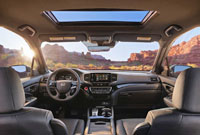
Along with the 20-inch alloy wheels noted earlier, which is the standard diameter across the entire Passport line, we can safely assume that Canadian-spec models will also get the Honda Sensing suite of advanced driver assistive and safety systems as standard equipment, that includes Collision Mitigation Braking System (CMBS) with Forward Collision Warning (FCW), Road Departure Mitigation (RDM) including Lane Departure Warning (LDW), Lane Keeping Assistance System (LKAS) and Adaptive Cruise Control (ACC). These advanced electronics are joined by the industry’s usual assortment of active and passive safety features and Honda’s proprietary Advanced Compatibility Engineering (ACE) body structure, resulting in a mid-size SUV designed to exceed current crash test standards.
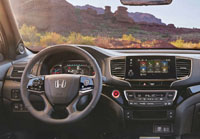
Additional standard features available south of the 49th that should be included in our Passport include LED headlights, LED DRLs, LED fog lamps, and LED taillights, proximity-sensing keyless Smart Entry and Smart Start, a 7.0-inch digital colour TFT primary instrument cluster, a configurable multi-information display featuring audio, trip and phone info (plus turn-by-turn route guidance on models with navigation), tri-zone automatic climate control, a 5.0-inch infotainment display, the aforementioned Multi-Angle Rearview Camera with dynamic guidelines, six-speaker 215-watt audio with a subwoofer, and much more.
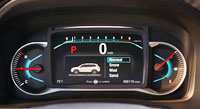
In the U.S., Honda includes Blind Spot Information in EX-L, Touring and Elite trims, and adds Rear Cross-Traffic Detection plus front and rear parking sensors to the Touring and Elite, while additional upgrades (depending on trim) include power-folding auto-dimming side mirrors, a larger 8.0-inch infotainment touchscreen with Apple CarPlay and Android Auto smartphone integration and smartphone/tablet-style tap, swipe and pinch gesture capability, satellite-linked navigation, 4G LTE in-vehicle Wi-Fi that can support up to seven devices, wireless phone charging, 590-watt 10-speaker premium audio, various HondaLink cloud-based services such as remote unlocking, concierge services, and stolen vehicle tracking, a powered moonroof, second-row sunshades, a power tailgate with available hands-free operation, plus more.
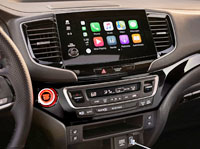
Plenty of Honda Genuine Accessories will also be available for the new Passport, many of which were shown off in the photos provided for this overview. Included are various sizes of roof storage boxes, a roof basket, plus roof-mounted bike, kayak and ski/snowboard racks, while Passport owners can also protect the cargo area with hard plastic floor, side, and seatback covers. Additionally, the storage area under the load floor can be sectioned off with individual, removable, washable bins.
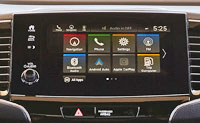
Honda will also be offering a number of cosmetic upgrades including a coloured graphics package, undercarriage welcome lights, and illuminated doorsills, while two accessory packages will be available as well, including The Adventure Package that adds fender flares, running boards, a trailer hitch, and more, plus The Urban Package featuring unique 20-inch alloy wheels, front and rear underbody spoilers, roof rails with crossbars, and the just noted cargo storage bins. Again, we’ll need to wait until Honda Canada reveals our Canadian-spec Passport before confirming everything on this list, but we can be certain that some, if not all of these items will be available here.
As noted earlier, a key reason for stepping up into a mid-size five-occupant SUV over a compact one like the CR-V is increased interior volume, so along with more passenger volume front to back the new Passport provides 368 litres (13.0 cubic feet) of additional passenger volume over its smaller sibling, its 3,282 litres (115.9 cu ft) ahead of the rear seatbacks resulting in segment-leading status, while the Passport’s 4,448 litres (157.1 cu ft) of overall interior volume is also best-in-class.
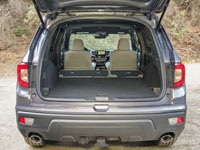
The Passport continues to lead the class when it comes to cargo hauling too, with 1,166 litres (41.2 cu ft) of luggage space behind the rear seats and 2,206 litres (77.9 cu ft) with the rear row lowered, which is also 56 litres (2.0 cu ft) more cargo space than the CR-V offers in the very back, and 60 litres (2.1 cu ft) more overall. Like with the CR-V, the Passport’s 60/40-split rear seatbacks fold automatically via releases in the cargo area, but the larger SUV uses electric buttons instead of levers, while the Passport also provides a reversible cargo floor that swaps out the carpeting for an easily maintained hard plastic surface.
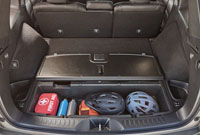
Another segment-leading bonus is underfloor storage, which measures 71 litres (2.5 cu ft) on its own and can be accessorized as noted earlier.
Stowage in mind, all Passport trims feature a large centre console bin between front occupants, while its roll top cover doubles as a handy tray when closed. There’s more centre console storage ahead of the gear selector, while the door panels provide even more places to put things.
Honda promises “high-quality interior appointments” including “generous use of soft-touch surfaces on the dash and doors,” plus “attractive and durable” fabric upholstery in the base Sport model and optional perforated leather with EX-L, Touring and Elite trims.

After all is said and done, no one should discount the role styling plays in automotive decision-making, and fortunately the Passport benefits from the new 2019 Pilot’s design influence. The latter is better looking than previous generations and the new Passport is arguably more so, thanks to a taller more 4×4-capable looking stance and sporty matte black used for the grille, headlights, bumpers, and wheels, plus glossy black trim in key areas, sharp looking LED headlight accents, unique floating C-pillars, and sporty chrome dual exhaust outlets. Each trim will get exclusive alloy wheel designs too, but so far there’s no word about Honda replacing some of the scratch-resistant blackened trim with dressier body-colour paint and satin-silver or chrome for a city-slicker version, but something similar makes sense for a future base model as well as alternative high-end trims.
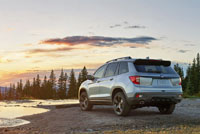
All in all it appears Honda has a winner on its hands, particularly because it targets the more popular five-passenger mid-size SUV market segment with an attractive, roomy, well-equipped entry sporting above-average performance and no shortage of high-tech features. Its rugged styling and off-road capability make certain the Passport targets a different kind of customer than the smaller CR-V, and truly opens up opportunity for a more rugged Ridgeline and other more adventuresome products in the future. Hopefully this new Honda swagger is a sign of things to come.
Now, make sure to check out the photo gallery above and watch the following short video that was released as part of the Passport’s Los Angeles Auto Show launch event:
Introducing the All-new 2019 Honda Passport (0:54):

